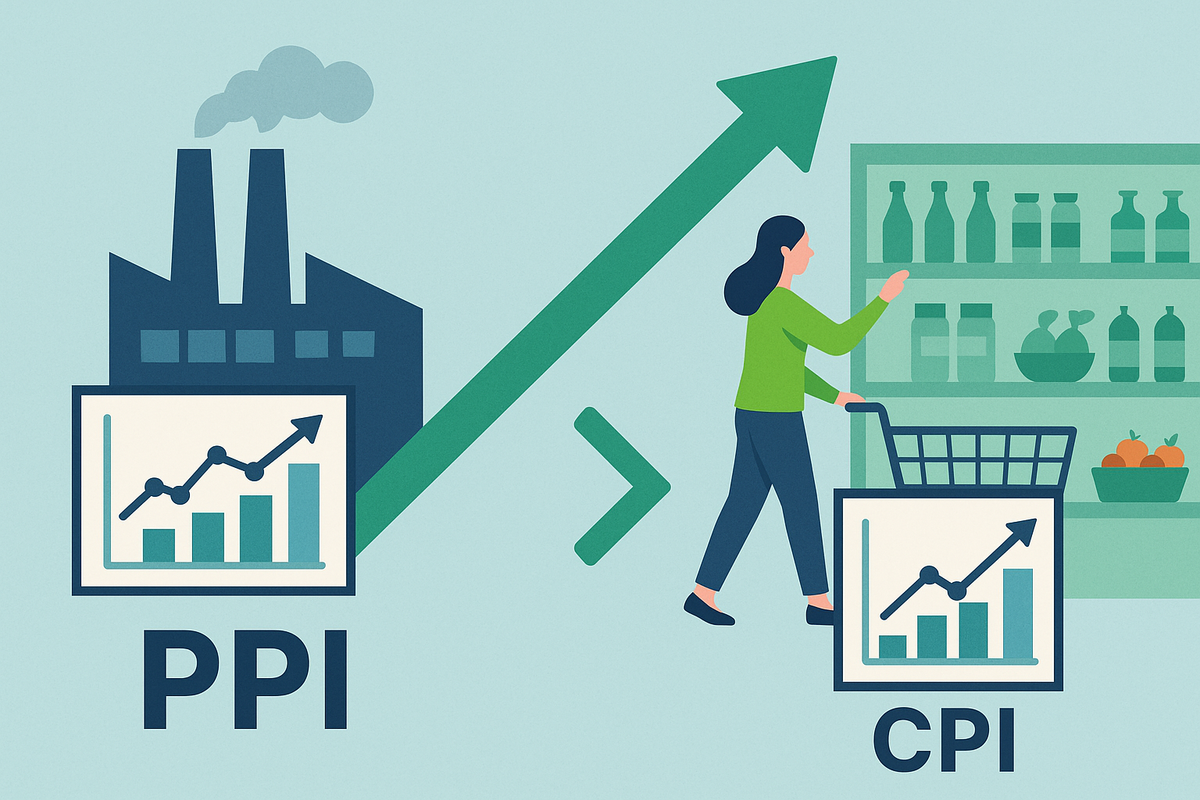
The Producer Price Index (PPI) and the Consumer Price Index (CPI) are two fundamental economic indicators that measure inflation, but they do so from different vantage points within the economy. While both are crucial for understanding price changes and their impact, the PPI tracks inflation from the perspective of producers, reflecting wholesale prices, whereas the CPI measures inflation from the perspective of consumers, reflecting retail prices. Understanding the distinctions and relationships between these two indices is vital for businesses, consumers, and policymakers in assessing economic health and making informed decisions.
Key Information
Producer Price Index (PPI)
The Producer Price Index (PPI) measures the average change over time in the selling prices received by domestic producers for their output. It essentially tracks inflation at the wholesale level, reflecting price changes from the perspective of the seller. Published monthly by the U.S. Bureau of Labor Statistics (BLS), the PPI was historically known as the Wholesale Price Index (WPI) until 1978.
The PPI system encompasses a wide range of sectors involved in producing goods, including mining, manufacturing, agriculture, fishing, forestry, gas, electricity, waste, and scrap materials. It also covers services in industries such as trade, transportation, warehousing, finance, and healthcare. The prices included in the PPI are typically from the first commercial transaction for many products and services.
How is the Producer Price Index (PPI) Calculated?
The calculation of the PPI employs a modified Laspeyres index formula. The general approach involves comparing the average weighted price of goods and services produced in the U.S. during the current month or year to their average weighted prices during a designated base month or year, with the result then multiplied by 100. For instance, if the average weighted price in July 2023 was $120 and in the base month (e.g., January 2022) was $100, the PPI for July 2023 would be calculated as ($120 / $100) x 100 = 120.
The BLS collects approximately 64,000 price quotations each month from over 16,000 establishments. Sampled items are weighted based on their size and importance. PPI calculations often use 100 as their base value, with some PPIs having an index base set at 1982=100. The PPI excludes Value Added Tax (VAT) and similar deductible taxes but includes any subsidies received by the producer.
The BLS categorizes PPIs into three main structures:
- Industry-Based PPIs: Track price changes at the production level for specific industries.
- Commodity-Based PPIs: Track price fluctuations based solely on products, grouping them by similarity, usage, and composition, irrespective of industry or origin.
- Final Demand-Intermediate Demand (FD-ID) Based PPIs: Use commodity price indexes based on the type of buyer, distinguishing between final demand customers (who purchase finished products) and intermediate buyers (who purchase semi-finished products for further production).
Significance of the PPI
The Producer Price Index holds significant importance as an economic indicator for several reasons:
- Inflation and Deflation Measurement: The PPI quantifies inflation (or deflation) from the perspective of producers, indicating changes in the prices they receive for their output.
- Economic Health Indicator: It serves as a strong indicator of the overall health of the economy.
- Leading Indicator of Consumer Inflation: One of its most crucial roles is as a leading indicator of consumer inflation. Changes in producer prices, particularly for raw materials and intermediate goods, often precede changes in consumer prices (measured by the CPI), as businesses may pass increased production costs onto consumers.
- Forecasting and Policy Tool: Economists, policymakers, and investors utilize PPI data to forecast economic trends, adjust monetary policies, and plan production strategies.
- Contract Escalation Clauses: The PPI is frequently used to calculate escalator clauses in private contracts, allowing for price adjustments based on changes in key input costs.
- GDP Measurement: It helps in measuring the final Gross Domestic Product (GDP) and in separating the inflation-unadjusted nominal GDP.
- Federal Reserve Influence: Both the PPI and CPI are heavily scrutinized by traders and are used by the Federal Reserve to assess economic developments and influence decisions on interest rates. A significant increase in PPI can prompt central banks to consider raising interest rates to curb inflation.
- Core PPI: To provide a more stable reading by excluding volatile components, the BLS also calculates "Core PPI" indexes, which typically exclude prices for food, energy, and trade services.
Consumer Price Index (CPI)
The Consumer Price Index (CPI) is a crucial economic indicator that measures the average change over time in the prices paid by urban consumers for a "market basket" of consumer goods and services. Calculated and published monthly by the Bureau of Labor Statistics (BLS) in the United States, the CPI serves as a primary gauge of inflation and deflation, reflecting the health and direction of the economy.
How the CPI is Calculated
The calculation of the CPI involves several key steps:
- Defining the Market Basket: The CPI is based on a figurative "market basket" of goods and services that are commonly purchased by American consumers. This basket includes a wide range of items, such as food, housing, transportation, medical care, apparel, education, communication, and recreation. The composition of this basket is periodically updated to reflect changes in consumer spending habits.
- Data Collection: Each month, the BLS collects approximately 80,000 price quotes from a sample of retail stores, service establishments, rental units, and doctors' offices across 87 urban areas in the U.S.
- Quality Adjustments: The collected prices are adjusted for any changes in the quality or features of the products to ensure that the index reflects pure price changes rather than improvements or degradations in goods.
- Weighting: Each item in the market basket is assigned a weight that corresponds to its importance in the overall spending patterns of the target population. For instance, housing expenses typically account for a larger share of household spending and are thus given greater weight in the calculation.
- Formula Application: The CPI is calculated using a formula that compares the cost of the market basket in the current period to its cost in a predetermined base period. The formula is: CPI = (Cost of Basket in Current Year / Cost of Basket in Base Year) × 100. For the U.S. CPI, the base period is typically the average of prices from 1982 to 1984, which is set at an index value of 100. The BLS also uses a geometric mean formula for averaging prices within most item categories.
- Population Groups: The BLS produces different CPIs for various population groups. The most commonly referenced is the CPI for All Urban Consumers (CPI-U), which covers over 90% of the U.S. population. A subset, the CPI for Urban Wage Earners and Clerical Workers (CPI-W), represents about 30% of the U.S. population.
Significance of the CPI
The CPI holds significant importance for various stakeholders and economic functions:
- Inflation Measurement: It is the most widely recognized measure of inflation, indicating how prices are rising or falling and how this affects the cost of living and consumers' purchasing power.
- Economic Policy: Governments and central banks, such as the Federal Reserve, closely monitor CPI data to formulate monetary policy, including decisions on interest rates.
- Income Adjustments: The CPI is used to make Cost-of-Living Adjustments (COLAs) for various income payments, including annual adjustments to Social Security benefits and pensions.
- Wage Negotiations: Employers and unions often use CPI data as a benchmark for wage adjustments in collective bargaining agreements.
- Poverty Thresholds: The Census Bureau utilizes the CPI to adjust the official poverty threshold annually.
- Economic Analysis: Economists use CPI data to deflate other economic series, such as measuring Real Gross Domestic Product (GDP), by stripping out the effects of inflation.
Context and Background
Similarities Between PPI and CPI
Both the PPI and CPI are:
- Economic Indicators: They are widely watched economic indicators used to assess developments in the economy.
- Measures of Price Change: Both calculate the change in price of a set of goods and services over time.
- Inflation Trackers: They are used to track inflation, which is the rate at which prices for goods and services rise.
- Monthly Releases: Both are released monthly by the U.S. Bureau of Labor Statistics (BLS).
- Used by Policymakers: Central banks, such as the Federal Reserve, utilize data from both CPI and PPI to gauge inflationary pressures and inform decisions on interest rates and monetary policy.
- Can be "Core": Both indices have "core" versions that exclude volatile categories like food and energy prices to provide a clearer picture of underlying inflation trends.
Key Differences Between PPI and CPI
The fundamental differences between PPI and CPI stem from their distinct perspectives on price changes within the economy:
- Perspective of Measurement:
- PPI (Producer Price Index): Measures the average change over time in the selling prices received by domestic producers for their output. It reflects prices from the viewpoint of the seller or manufacturer.
- CPI (Consumer Price Index): Measures the average change over time in the prices paid by urban consumers for a fixed "basket" of consumer goods and services. It reflects prices from the viewpoint of the purchaser or consumer.
- Scope and Coverage:
- PPI: Focuses on prices received by producers across the entire chain of production, including raw materials, intermediate manufacturing, and finished goods. It aims to track prices of all output from U.S. producers, including sales to other businesses, for capital investment, to retail/wholesale sectors for resale, or directly to consumers, government, and exports. PPI does not include imports.
- CPI: Targets prices paid by consumers for a fixed basket of goods and services, which includes categories like food and beverages, housing, apparel, transportation, medical care, recreation, education, and communication. CPI includes imports, as consumers purchase both domestic and imported goods and services.
- Inclusion of Taxes and Margins:
- PPI: Sales taxes are generally not included in the PPI because they do not directly benefit the producer. For retail and wholesale trade, PPI reflects changes in gross margins (the difference between selling price and acquisition price).
- CPI: Sales taxes are included in the CPI because they directly impact the price consumers pay.
- Specific Inclusions/Exclusions:
- PPI: Includes prices for goods and services purchased by third parties, such as medical services paid for by employers or the government. It also separates the costs of transporting, retailing, and wholesaling goods from the cost of the good itself, classifying trade and transportation as services.
- CPI: Only includes components of personal consumption directly paid for by the consumer, such as direct payments for medical care. It includes certain housing cost estimates that PPI does not.
- Purpose and Use:
- PPI: Primarily used to deflate revenue streams to measure real growth in output. It provides insights into changes in production costs.
- CPI: Primarily used to adjust income and expenditure streams for changes in the cost of living, such as Social Security benefits and wage adjustments.
- Weighting and Formula:
- Both use a modified Laspeyres index formula, but the CPI updates weights annually, while the PPI updates weights every five years. The CPI also uses a geometric mean formula at the item level, which the PPI does not, potentially leading to lower inflation measures in periods of price increases due to reduced substitution bias.
How They Relate to Inflation
Both PPI and CPI are vital for understanding inflation, but they offer different perspectives and can act as indicators for each other:
- Direct Measures of Inflation: Both indices directly measure inflation, with CPI being the most commonly referenced measure for consumer inflation and the cost of living.
- PPI as a Leading Indicator: Changes in the PPI can often serve as a leading indicator for future changes in the CPI. This is because if producers face higher costs for raw materials, intermediate goods, or labor (as reflected in the PPI), they may pass these increased costs on to consumers in the form of higher retail prices, which would then be reflected in the CPI.
- Divergences: While there's an intuitive link, the relationship between PPI and CPI is not always straightforward, and they can diverge. Factors such as the inclusion of imports in CPI (but not PPI), differences in sales tax treatment, and businesses absorbing cost increases due to competitive pressures can lead to situations where PPI rises while CPI rises more slowly or not at all, or vice versa.
- Monetary Policy: Both indices are closely monitored by central banks like the Federal Reserve to assess inflationary pressures and guide monetary policy decisions, such as adjusting interest rates to maintain a stable inflation rate (e.g., around 2%).
Implications
Implications for Businesses
- Cost Forecasting and Pricing Strategies: Businesses closely monitor PPI data to anticipate future production costs. A rising PPI signals increasing input costs, prompting companies to re-evaluate their pricing strategies to maintain profit margins. Conversely, a flat PPI might suggest limited pricing power, leading businesses to prioritize cost-cutting measures.
- Corporate Margins: Surges in the PPI, often influenced by factors like tariffs, can significantly impact corporate profit margins. Businesses may initially absorb these increased costs, but as pressures mount, they often pass them on to consumers.
- Investment and Capital Expenditures: When producers face a flat PPI and perceive limited ability to raise prices, they may become less inclined to invest in expansion or new projects, potentially affecting job creation and overall economic activity.
- Pricing Strategies and Sales (CPI): An increase in CPI indicates rising consumer prices, prompting businesses to re-evaluate their pricing strategies and cost management practices to remain competitive and maintain sales volume.
- Understanding Consumer Behavior (CPI): CPI data helps businesses understand consumer spending patterns, allowing them to adjust product pricing and marketing strategies accordingly.
Implications for Consumers
- Future Price Hikes (PPI): The PPI is considered a leading indicator of inflation. When producer prices rise, it often signals that higher costs will eventually "trickle down" to consumers in the form of increased retail prices for goods and services.
- Impact of Tariffs (PPI): Increases in the PPI due to tariffs on imported goods can lead to higher prices for consumers, as businesses pass on these additional expenses.
- Purchasing Power (CPI): The CPI directly impacts consumers' purchasing power. When the CPI rises, it means that the same amount of money buys fewer goods and services, effectively reducing consumers' real income.
- Wage and Salary Adjustments (CPI): The CPI is frequently used to adjust wages, salaries, and various income payments, such as Social Security benefits and pensions, to account for inflation and maintain purchasing power.
- Spending and Saving Decisions (CPI): Stable consumer prices, as indicated by a flat CPI, can encourage consumers to make larger purchases, which supports economic growth.
- Housing and Mortgage Rates (CPI): Changes in the CPI can influence the housing market and mortgage rates. When the CPI rises, central banks may increase interest rates, leading to higher mortgage rates and potentially dampening home-buying demand.
Implications for Economic Policy
- Monetary Policy and Interest Rates: Policymakers, particularly central banks like the Federal Reserve, heavily scrutinize both PPI and CPI data to assess inflationary pressures. A significant rise in either index can make the Fed less inclined to cut interest rates, as such a move could further stimulate inflation. Conversely, a period of low or negative CPI growth might lead central banks to cut rates to stimulate economic activity.
- Inflation Control: PPI data serves as an early warning sign for potential inflation, guiding central banks in their efforts to maintain price stability. The CPI is a primary indicator used by central banks to formulate monetary policy.
- Government Fiscal Policy: The CPI serves as a critical tool for governments to assess inflation trends and overall economic health, guiding decisions on fiscal policies. It also acts as a "scorecard" for the effectiveness of the government's economic policies.
- Adjusting Dollar Values: The CPI is used to adjust dollar values for a wide range of social service programs, government assistance, and federally mandated cost-of-living increases.
Summary
The Producer Price Index (PPI) and the Consumer Price Index (CPI) are both vital measures of inflation, but they capture price changes at different stages of the economic pipeline. The PPI reflects the prices received by domestic producers for their output, serving as an indicator of wholesale inflation and often a leading indicator for future consumer prices. The CPI, on the other hand, measures the prices paid by urban consumers for a basket of goods and services, directly reflecting the cost of living and consumer purchasing power. While the PPI provides insights into production costs and potential upstream inflationary pressures, the CPI directly impacts household budgets and is widely used for income adjustments. Both indices are closely monitored by policymakers, businesses, and consumers to understand inflationary trends, guide monetary policy decisions, inform pricing strategies, and manage personal finances.






